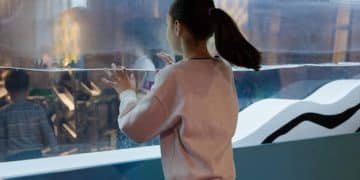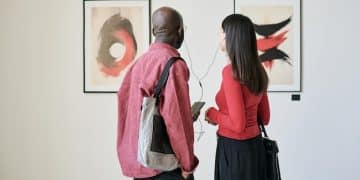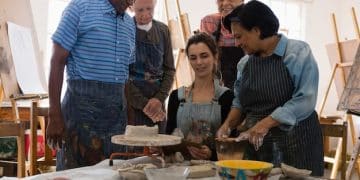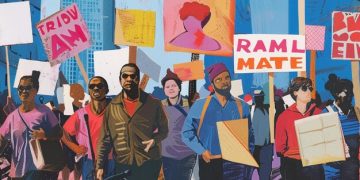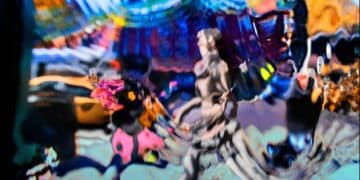How the Pandemic Reshaped Art Consumption in America
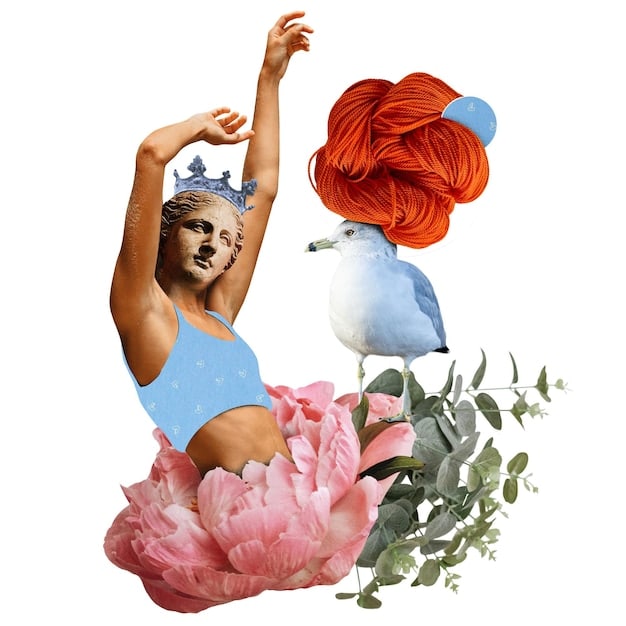
The pandemic fundamentally altered how Americans consume art, accelerating the shift towards digital platforms, emphasizing accessible and community-driven art experiences, and influencing the themes and forms of artistic expression.
The COVID-19 pandemic brought unprecedented changes to nearly every aspect of American life, and the way we engage with art was no exception. From shuttered museums to canceled performances, the traditional avenues for experiencing art were abruptly cut off. This led to a surge in digital art consumption and a re-evaluation of the very definition of art in the age of social distancing. This article explores how the pandemic has changed the way Americans consume art, examining the shifts in access, engagement, and the art itself.
The Initial Shock: Closure of Traditional Art Venues
The onset of the pandemic in early 2020 brought immediate and drastic measures, including the closure of museums, theaters, galleries, and concert halls across the United States. These venues, which had long served as the primary spaces for experiencing art, suddenly became inaccessible, leaving art institutions and consumers alike scrambling for alternatives.
The Impact on Museums and Galleries
Museums and galleries faced a particularly difficult situation, as their business model relied heavily on in-person attendance. The closure of these spaces not only deprived the public of access to art but also resulted in significant financial losses for the institutions themselves.
Performance Arts in Peril
The performing arts, including theater, dance, and music, were similarly affected. Live performances were canceled, and artists and performers found themselves out of work. The loss of income and the uncertainty of the future forced many to reconsider their careers and explore new avenues for artistic expression.
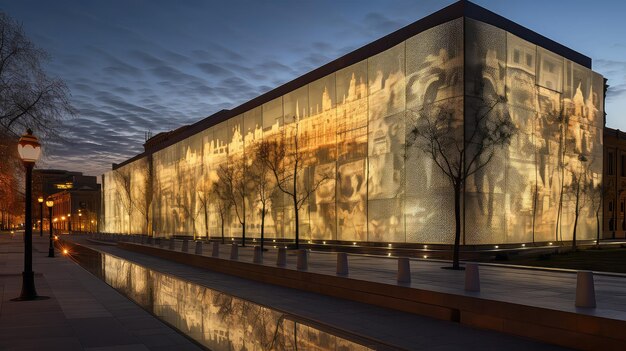
The closure of traditional art venues created a void in the cultural landscape, prompting a rapid and widespread adoption of digital alternatives. This shift had profound implications for the accessibility, reach, and nature of art consumption.
- **Digital Transformation:** Art institutions rapidly adopted online platforms.
- **Financial Challenges:** Venues faced significant financial strain.
- **Artistic Innovation:** Artists explored creating digital or socially distanced art.
In summary, the initial impact of the pandemic involved the shuttering of traditional art venues, financial strain, and the rapid search for digital alternatives, marking a significant turning point in how Americans engage with art.
The Rise of Digital Art Consumption
With traditional art venues closed, Americans turned to the internet to satisfy their cultural cravings. This led to a surge in digital art consumption, with museums, galleries, and artists offering virtual tours, online exhibitions, and streaming performances.
Virtual Tours and Online Exhibitions
Many museums and galleries invested in creating virtual tours of their collections, allowing users to explore the art from the comfort of their own homes. These virtual tours often included interactive elements, such as audio commentary, high-resolution images, and 360-degree views.
Streaming Performances and Online Concerts
The performing arts also embraced the digital realm, with theaters, dance companies, and orchestras streaming performances online. These streaming events often featured live Q&A sessions with the artists, providing a more interactive and engaging experience for viewers.
The rise of digital art consumption expanded the reach and accessibility of art, allowing people from all over the country to experience cultural events that they might not have otherwise been able to access. While these online offerings could make art more accessible for geographically remote audiences or those with mobility issues, they also brought new challenges related to digital equity and the potential for a digital divide.
- **Increased Accessibility:** Digital platforms allowed broader access to art.
- **Interactive Experiences:** Online events offered new ways to engage with artists.
- **Digital Divide Issues:** Not everyone can access digital art equally.
To conclude, digital transformation offered new opportunities for both arts organizations and art consumers, but it also revealed existing inequalities in access to digital infrastructure and literacy, requiring thoughtful strategies for ensuring equitable participation.
Democratization of Art: Social Media and DIY Creativity
The pandemic also accelerated the democratization of art, with social media platforms like Instagram, TikTok, and YouTube becoming important venues for artists to share their work and connect with audiences. This created new opportunities for emerging artists and challenged the traditional gatekeepers of the art world.
The Power of Social Media for Artists
Social media platforms allowed artists to bypass traditional galleries and curators, reaching a wider audience directly. This was particularly beneficial for artists working in emerging or unconventional mediums, who may have struggled to gain recognition through traditional channels.
DIY Art and Creative Expression
The pandemic also inspired many people to explore their own creativity, with DIY art projects and online tutorials becoming increasingly popular. This led to a surge in amateur art-making, as people sought new ways to express themselves and cope with the stress and isolation of the pandemic.

This shift towards DIY creativity challenged the traditional hierarchies of the art world, blurring the lines between professional and amateur artists. Platforms made art accessible to more people, encouraged creative engagement, and fostered a sense of community.
- **Breaking Barriers:** Social media enables artists to bypass traditional systems.
- **Growth of Amateur Art:** More people explored creative expression at home.
- **Artistic Communities:** Online groups foster a sense of belonging.
Generally, the democratization of art brought new voices and perspectives to the forefront, broadened participation in the art world, and redefined the relationship between artists and audiences.
Thematic Shifts: Art Reflecting Pandemic Experiences
The pandemic not only changed how art was consumed but also influenced the themes and content of the art itself. Artists began to explore the themes of isolation, loss, resilience, and social justice, reflecting the shared experiences of the pandemic era.
Art as a Mirror to Society
Art has always served as a mirror to society, reflecting the hopes, fears, and anxieties of the times. The pandemic was no exception, with artists using their work to process and express the profound changes and challenges of the era.
Focus on Social Justice and Inequality
The pandemic also exposed and exacerbated existing social inequalities, prompting artists to address issues of racial justice, economic inequality, and healthcare disparities in their work. This led to a surge in art that was both aesthetically compelling and politically engaged.
Here are some of the main features that can be added:
- **Reflecting Reality:** Art captured societal struggles during the pandemic.
- **Addressing Injustice:** Artists highlighted social justice issues.
- **Promoting Empathy:** Art connected through shared experiences.
In conclusion, art became a powerful medium for processing, understanding, and responding to the pandemic, providing a platform for marginalized voices and promoting empathy and understanding during a time of great division.
The Hybrid Future: Blending Physical and Digital
As the pandemic subsides, the art world is beginning to explore a hybrid model that blends physical and digital experiences. This approach seeks to combine the best of both worlds, offering both in-person and online access to art.
Augmented Reality and Interactive Installations
Many museums and galleries are incorporating augmented reality (AR) and interactive installations into their exhibitions, creating more immersive and engaging experiences for visitors. These technologies allow visitors to interact with the art in new ways, enhancing their understanding and appreciation.
Hybrid Events and Performances
The performing arts are also experimenting with hybrid events, offering both in-person and streaming options for audiences. This allows people to choose the format that best suits their needs and preferences, increasing accessibility and expanding reach.
The hybrid model is not without its challenges, as it requires art institutions to invest in both physical and digital infrastructure. Balancing these considerations is critical for the long-term viability of the sector.
- **Immersive Technology:** AR enhances in-person experiences.
- **Flexible Access:** Hybrid events cater to diverse audiences.
- **Sustainability:** Long-term investment is critical.
The movement towards a hybrid future points to a more flexible, inclusive, and sustainable art ecosystem, adapting to diverse audience needs and preferences while retaining the unique value of both physical and digital experiences.
Long-Term Effects: Lasting Changes in Art Consumption
The pandemic has had a profound and lasting impact on the way Americans consume art. While it is still too early to fully understand the long-term effects, some trends are already becoming clear.
Increased Digital Literacy and Comfort
The pandemic forced many people to become more comfortable with digital technology, which is likely to have a lasting impact on their art consumption habits. People who previously avoided online art experiences may now be more open to exploring virtual tours, streaming performances, and online exhibitions.
Greater Emphasis on Accessibility and Inclusion
The pandemic also highlighted the importance of accessibility and inclusion in the art world. Art institutions are now more aware of the need to reach diverse audiences and provide equitable access to cultural experiences. This is likely to lead to more initiatives aimed at making art more accessible to people with disabilities, people of color, and people from low-income backgrounds.
There are a few trends that we can see:
- **Digital Integration:** Digital art will remain a central part of culture.
- **Inclusive Practices:** Accessibility and inclusion are more valued.
- **Community Focus:** Community-driven art will gain importance.
As a consequence, the pandemic has accelerated existing trends and catalysed new developments, resulting in a more equitable, inclusive, and sustainable art world that is both accessible and socially relevant.
| Key Point | Brief Description |
|---|---|
| 🏛️ Venue Closures | Traditional venues closed, leading to digital alternatives. |
| 📱 Digital Shift | Online tours and streaming increased art accessibility. |
| 🎨 DIY Creativity | Home-based creativity gained popularity via social media. |
| 🎭 Thematic Shifts | Art began to reflect pandemic experiences, focusing on isolation and injustice. |
Frequently Asked Questions
▼
Museums quickly pivoted to offering virtual tours, online exhibitions, and digital collections to maintain engagement with audiences and provide access to art from home.
▼
Social media platforms became vital for artists to share their work, engage with audiences directly, and democratize access to art, bypassing traditional galleries.
▼
Artists focused on themes like isolation, loss, resilience, and social justice, reflecting the collective experiences and challenges faced during the pandemic.
▼
The hybrid model blends physical and digital art experiences, offering both in-person visits and online access, such as virtual tours and live-streamed performances, to cater to a wider audience.
▼
Expect increased digital literacy, a greater emphasis on accessibility and inclusion, and a continued growth of community-driven art experiences, leading to a more equitable and inclusive art world.
Conclusion
In conclusion, the pandemic has irrevocably altered the landscape of art consumption in the United States. From the initial shock of venue closures to the rise of digital art and the democratization of creative expression, the changes have been profound and far-reaching. As the art world moves towards a hybrid future, it is essential to embrace the lessons learned during the pandemic and continue to prioritize accessibility, inclusivity, and innovation in order to ensure that art remains a vibrant and vital part of American culture.
